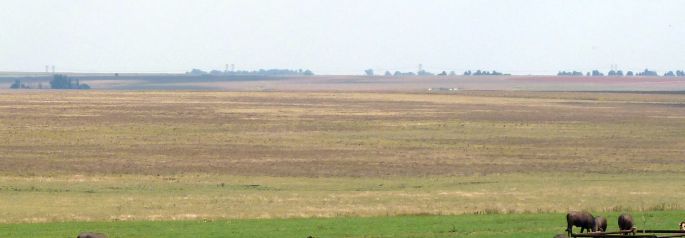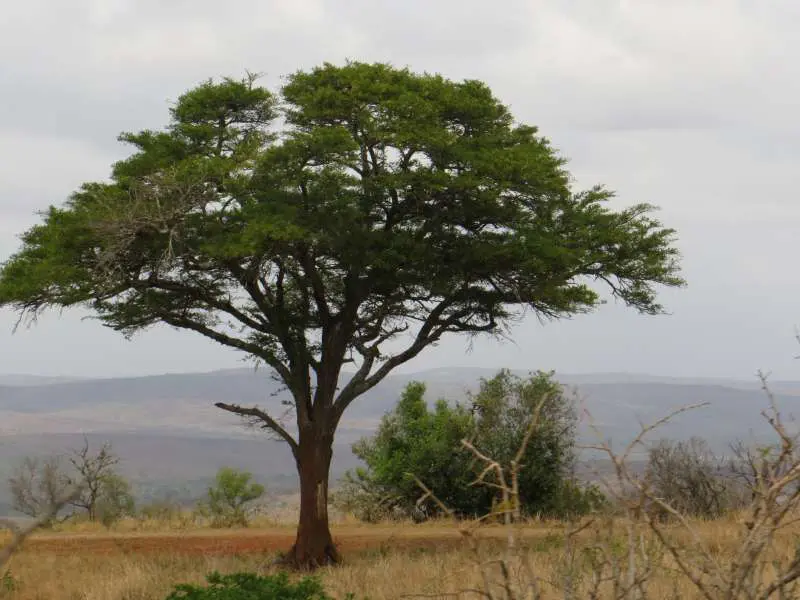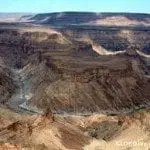
Plateau high above sea level from a highway stop east of Pretoria. The plateau was eroded into sediments of the Karoo basin by floodwaters receding in wide sheets after the ocean basins began to open and deepen. The sediments of the Karoo basin exposed across this plateau contain vast coal deposits used for electricity generation at numerous power stations.
About 4,500 years ago, the African continent was entirely covered with water. We know this is true because humans witnessed the event, recorded what they saw, and the document they wrote is available to us today. About that water and its depth that account reads:
For forty days the flood kept coming on the earth, and as the waters increased they lifted the ark high above the earth. The waters rose and increased greatly on the earth, and the ark floated on the surface of the water. They rose greatly on the earth, and all the high mountains under the entire heavens were covered. The waters rose and covered the mountains to a depth of more than twenty feet. (Genesis 7:17–20)
This was a period of great sedimentation on the earth, especially on the parts of the crust that now form the continents.
Once the waters of the Flood had completely inundated every piece of land on the earth, they began to recede, and they continued to recede for a period of about seven months, until the continents were dry. Where did the waters go? They flowed into the ocean basins which were widening at the time, or deepening, or both.
Geologists actually catch hints of this event but their interpretive framework, especially the dates they have assigned, prevents them from making the connection. For example, they speak of a time when the Indian and Atlantic Oceans were ‘born’—of the break-up of Gondwana. The ‘birth’ of these oceans provided the place for the waters to go:
The break-up of Gondwana began with the opening of the Indian Ocean along the African east coast, heralded by the eruption of basalts and rhyolites of the Lebombo region.1
This is the first hint of geological changes to the ocean basins, needed to receive the floodwaters. According to their evolutionary thinking it was some 180 million years ago, but in reality that translates to about ‘half way’ through the Flood. Here is another quote:
Some 120 million years ago, South America began to detach from Africa, opening rifts along the southern African west coast. This thinned the continental crust: the start of the Atlantic Ocean.2
The dates, as we mentioned, are subjective and made to agree with their long-age framework of thinking.
This is the second hint. The dates, as we mentioned, are subjective and made to agree with their long-age framework of thinking. If the relative timing is correct, and that would need to be checked, then it means that, during the Flood, the Indian Ocean opened up slightly before the Atlantic.
When we disregard the actual numbers quoted for the ‘dates’, this description and the events that follow fit nicely with what the Bible says. Of course, the two descriptions of the event are from two different observational locations: Noah was on the Ark watching the water rise and fall, while the geologists are now on the ground looking at its effects. This is what Noah recorded:
Now the springs of the deep and the floodgates of the heavens had been closed, and the rain had stopped falling from the sky. The water receded steadily from the earth. At the end of the hundred and fifty days the water had gone down, and on the seventeenth day of the seventh month the ark came to rest on the mountains of Ararat. The waters continued to recede until the tenth month, and on the first day of the tenth month the tops of the mountains became visible. (Genesis 8:2–5)
There is no doubt about the dates in the biblical account (e.g. “the seventeenth day of the seventh month” and “the first day of the tenth month”.) They are based on careful observation and recording of the event itself, which is the only reliable way of measuring elapsed time. No assumptions were involved—just observation.
Geologists catch further hints of the consequences of the receding stage of the Flood on the African continent:
There is no doubt about the dates in the biblical account. … They are based on careful observation and recording of the event itself, which is the only reliable way of measuring elapsed time.
Sedimentation and marine life during Gondwana’s break-up
Unlike the Karoo—where sedimentation occurred for nearly 120 million years, much of it on land, producing a complete record of terrestrial life during the Permian, Triassic and early Jurassic Periods—the later Jurassic and Cretaceous Periods during which the break-up of Gondwana occurred are poorly documented in the rocks of South Africa. During this time it seems that southern Africa was elevated and the interior was experiencing erosion. Sedimentation deposition was taking place mainly in the developing Indian and Atlantic oceans, now all off-shore areas.3
Note the statement, “During this time it seems that southern Africa was elevated”. That is consistent with the continent rising and emerging from beneath the floodwaters, just as the Bible records.
However, we should first clarify some of the evolutionary assumptions in this statement. Note that the filling of the Karoo basin did not take 120 million years but something of the order of a month or two. The sedimentation happened quickly because there was enormous geological energy involved in the filling process. Note too that the fossils in the Karoo do not provide a record of life over millions of years but record the order in which plants and animals were buried during the Flood, in particular its middle period just before the waters peaked.
Also, we need to hold lightly to the claim that the opening and deepening of the ocean basins actually involved the break-up of a supercontinent called Gondwana, with South America and Antarctica breaking away from southern Africa and moving to their present locations. This may be correct or the story may change with further research.
The key point is that the geological observations on southern Africa match the pattern expected from the biblical account of the Flood, when it says the waters stopped rising and began to recede from the earth.
The change in sedimentation on Africa described by geologists matches this change in water movement. When the waters were rising, the floodwaters were depositing sediment on the interior of Africa, ending with the enormous Karoo Basin. When the waters were receding, sedimentation was at the edges of the continent. Further, when the waters were rising, the interior of Africa was experiencing great sediment deposition. When the waters were receding the interior of Africa was experiencing great erosion. That is why the geologists speak of the break-up being “poorly documented”.
So, geologists do see the effects of Noah’s Flood, and document them quite remarkably. But they do not make the connection because of the uniformitarian glasses they are wearing by which they interpret the evidence. This philosophy is like mind-forged manacles. It makes them imagine the process took hundreds of millions of years. It would be interesting if geologists could free themselves to look through a different interpretive framework. If they would do this, even for a little while and for the adventure of exploring new ideas, it will be interesting to hear of the new insights that they will gain.








I recall during a David Reaves show a statement that there are “Rings of Round Rocks” created by shore waves at ? ft on Mt St Hellen’s during the “Flood”. I also understood this to be evidence on other mountains globally however cant find any information other than Wave Rock in Australia at 3200′. Please provide me info to confirm more Observable Scientific Proof.
Thank U